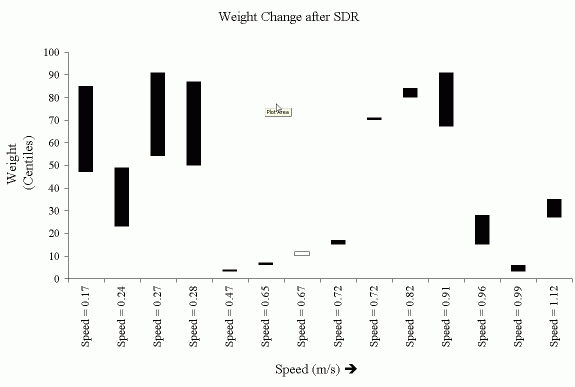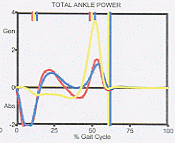|
Gait Inefficiency in Cerebral Palsy Injury to the central nervous system resulting in a net positive effect on peripheral tone is frequent both in adults and in childhood. Clinicians recognise the general features of the condition and patients suffer the spectrum of disability that it brings. The term Upper Motor Neurone syndrome has been coined for the constellation of features that are associated with such injuries (Sheean). Fibres passing from the cortex to the brainstem facilitate the action of the ventromedial reticular formation which is the main ‘tone suppressor’ through the dorsal reticulospinal tract. Paradoxically, the accompanying fibres passing from the cortex, travelling through the lateral corticospinal tract that end on the motor neurones in the cord have little tone suppressing effect and lesions of the pyramidal fibres in the internal capsule lead to a little clumsiness in the hands, mild hyper reflexia and a positive Babinski sign. Indeed Sheean prefers to call the fibres responsible for the spastic component of the UMNS parapyramidal . The general effect of the cerebral lesions seen in cerebral palsy is inhibitory . Generally the greater the extent of the lesion in terms of limb involvement, the greater the energy inefficiency seen:
Calory Burning Effect of Spasticity Muscle has a basal requirement for energy that is quite small compared with the quantities of energy produced during movement. Heat production from muscle increases with increasing activity as seen in shivering but where the tone in the muscle has been altered by spasticity significant increases in muscle energy consumption occur. An indirect exsample of this phenomenon is seen in the following data. The weight of a group of children who underwent selective dorsal rhizotomy for cerebral palsy diplegia went up dramatically, crossing weight centiles, particularly if the child was a slow walker initially. Similar findings have been reported following spasticity reduction produced by baclofen pump insertion.
Moment Arm Inefficiency Growth in the presence of spasticity often leads to the development of contractures that limit the ability of the hip and knee joint to extend during stance phase. The normal conservation of energy achieved by soleus controlling the advancement of the tibia during second rocker is foiled by these contractures and very high external flexing moments are present that require significant extra isometric contraction from the quadriceps and hip extensors. Muscle Fibre Alterations Differences have been found in studies of muscle morphology between both the variability of fibre sizes and the proportions of fibres. Rose et al (1994) found that the variation in fiber sizes tended to correlate with increases in EEI and that changes in fiber type correlated with prolongation of EMG activity. Stiff spastic muscle has a slightly shorter electromechanical delay than normal muscle (40msec vs 55 msec). Inefficient Mode of Muscle Action The efficiency of eccentric contraction is approximately three times greater than that of concentric contraction (Asmussen, 1953). Use of the eccentric action of muscle is extensive during weight acceptance during the loading response (first 10% of gait cycle) with tibialis anterior and quadriceps acting to brake the body. Cerebral palsy is often associated with an absence of heel strike and where the toe makes contact initially a spastic response occurs with an abnormal burst of concentric power generation where there should only be power absorption.
Co-contraction The British physiologist Sherrington (1919) identified a process termed reflex inhibition that leads to a controllable degree of suppression in antagonist muscles during unopposed activity. In cerebral palsy the effects of the upper motor neurone syndrome lead to a failure of this mechanism with antagonists firing at the same time as agonists Unnithan (1988). As normal children mature with respect to gait Frost suggests that a reduction in the use of co-contraction to stabilise limbs leads to a reduction in energy consumption. Confusingly, Damiano found that in children with cerebral palsy the children with higher levels of co-contraction of hamstrings and quadriceps showed a lower EEI whilst Unnithan (1996) found a higher energy cost associated with co-contraction. A fundamental aspect of the debate about co-contraction is whether it is a stabilising strategy employed by a child with control impairment (as suggested by Damiano)or whether it is an unwanted and uncontrolled aspect of the upper motor neurone syndrome that inevitable occurs as a result of the central nervous system injury. References Sheean G. The pathophysiology of spasticity. Europaean Journal of Neurology. 2002;9(Suppl 1):3-9. Rose J, Haskell WL, Gamble JG, Hamilton RL, Brown DA, Rinsky L. Muscle pathology and clinical measures of disability in children with cerebral palsy. J Orthop Res 1994;12(6):758-68. Asmussen E.Positive and negative muscular work. Acta Physiol Scand 1953;364-382. Unnithan VB, Clifford C, Bar OO. Evaluation by exercise testing of the child with cerebral palsy. Sports Med 1998;26(4):239-51. Frost G, Bar OO, Dowling J, Dyson K. Explaining differences in the metabolic cost and efficiency of treadmill locomotion in children. J Sports Sci 20(6):451-61. Damiano DL, Martellotta TL, Sullivan DJ, Granata KP, Abel MF. Muscle force production and functional performance in spastic cerebral palsy: relationship of cocontraction. Arch Phys Med Rehabil 2000;81(7):895-900. Unnithan VB, Dowling JJ, Frost G, Bar OO. Role of cocontraction in the O2 cost of walking in children with cerebral palsy. Med Sci Sports Exerc 1996;28(12):1498-504. Granata K, Ikeda AJ, Abel MF. electromechanical delay and reflex response in spastic cerebral aplsy. Arch Phys Med Rehabil 2000;81(7):888-894. |



